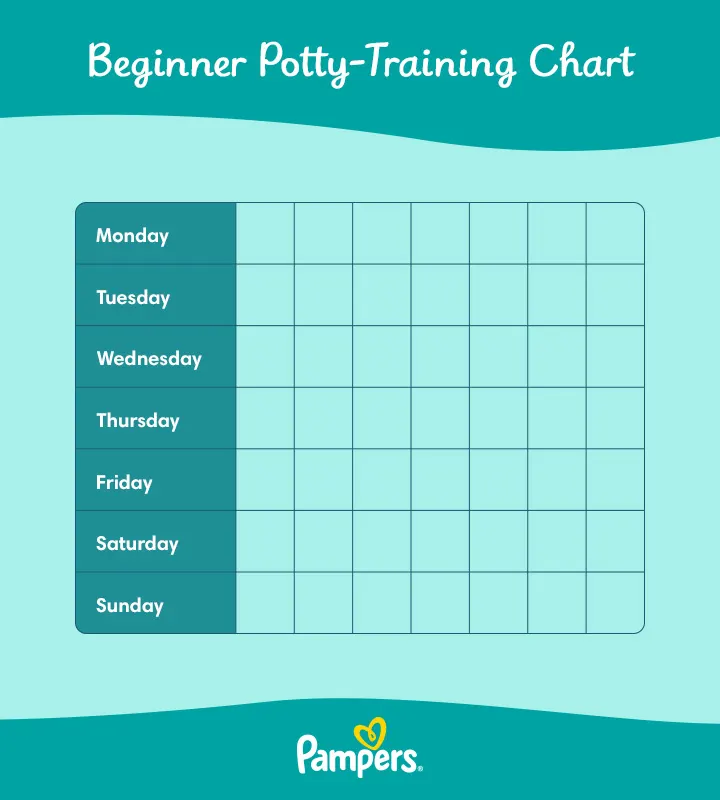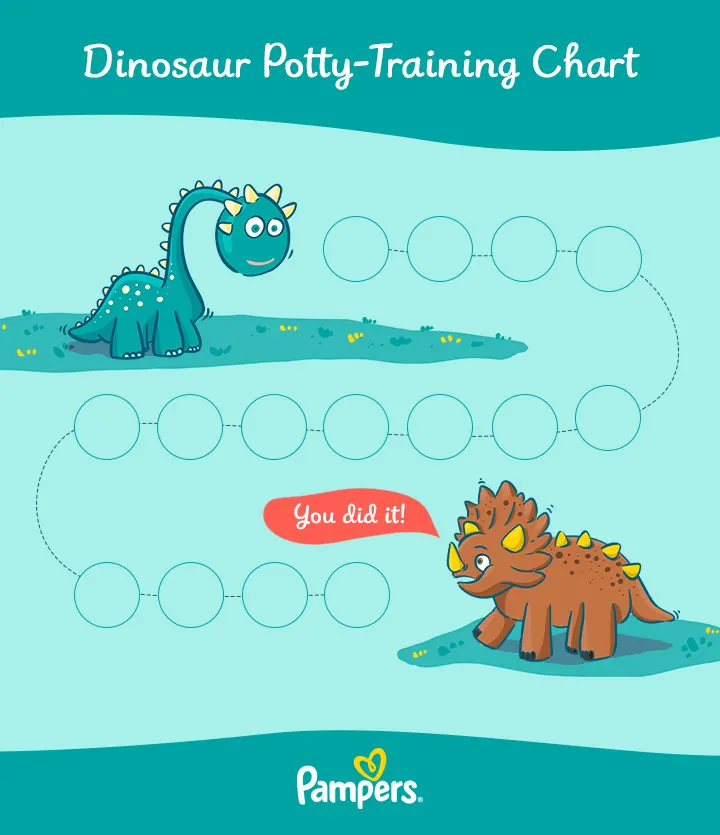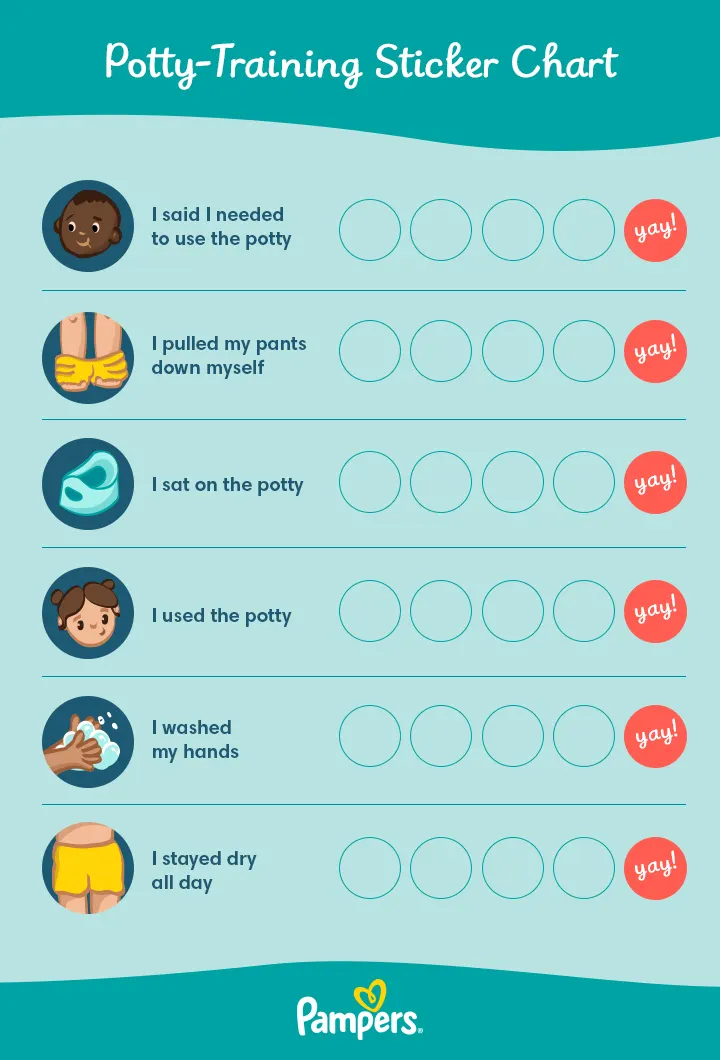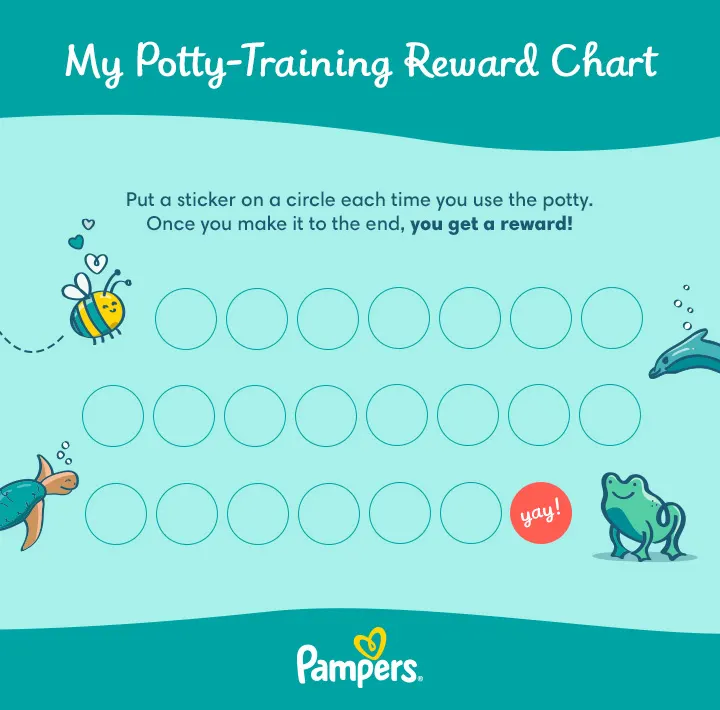
Printable Potty-Training Charts and Reward Ideas
5 min readUpdated January 10, 2024
5 min readUpdated January 10, 2024
Potty training is a major milestone in a child's development, but it can be challenging for parents and toddlers. That's where potty-training reward charts come in! These tools can help motivate little ones and make the journey fun. We'll explore different types of charts and how to use them effectively. Whether your toddler is a beginner or you’re looking to add more excitement, keep reading to learn all about potty training charts and how to reward your little one for their hard work, plus, we have some adorable and free printable charts available for download.
An Introduction to Potty-Training Charts
If your little one is ready to start potty training or they’re already on their journey and you’re finding motivating your child challenging, consider introducing a reward system. One such method that has proven to be beneficial for numerous parents is the use of a potty-training chart.
A potty-training chart serves as a tangible record of your little one’s accomplishments and habits throughout their potty-training journey. Every time they make significant progress or use the potty successfully, you can decorate the chart with a shiny star or a bright sticker, offering your emerging potty star some well-deserved applause and encouragement for their hard-earned triumphs.
Potty-Training Chart Benefits
Your encouragement, support, and patience may be all that’s needed to keep your little one on track with potty training. But sometimes, a gentle and fun incentive like a potty-training chart might help the process. Here are some benefits of using a potty-training chart:
Small but consistent rewards can motivate and empower your child, making potty training a more positive experience. Let's cheer on these little steps towards big milestones!
How to Encourage Potty Training Using a Chart
If you’re wondering how to encourage or reward potty training, one of the splendid features of potty-training charts is the ability to tailor them to suit your taste or the age of your little one. For instance, you might decide to award your youngster a sticker each time they successfully utilise the loo, or maybe you hand one over after a complete ‘dry day’. Some parents may opt to dish out stickers for every little triumph their toddler accomplishes, like requesting to use the potty, sitting on it, or washing their own hands.
For a great number of tots, simply placing a sticker or a shiny star on their potty-training chart is a reward in and of itself! Additionally, some parents might choose to give a small treat after a certain number of stickers are collected or dry days have been achieved. You could also adapt the objectives for older children, or as the potty-training advances, such as aiming towards ‘big kid’ pants.
How to Introduce a Potty-Training Reward Chart
Here are some tips for introducing a potty-training chart to your little one:
Potty-Training Reward Ideas
As mentioned above, the potty-training chart and stickers may be enough of a reward for your little one! The excitement they get from watching their chart fill up over the week may be all the encouragement they need. However, if your child needs a little extra incentive, you might consider a special reward if they reach the goals you set:
Of course, potty-training rewards are optional, but if you do decide to offer them, try to keep most of the focus on your little one gaining confidence and learning to use the potty rather than on getting new toys or treats.
Here are some more potty-training tips to help encourage your toddler on their new adventure.
Free Printable Potty-Training Charts
Here are some of our cute and free downloadable and printable potty-training reward and sticker charts for potty-training toddlers.
Beginner Potty-Training Chart
This potty-training chart is straightforward and ideal for those just starting out on their potty journey. It's neatly sectioned into days of the week, and all you need to do is place a sticker on the chart whenever your young'un uses the potty.
Even better, this printable reward chart is blank, allowing you and your little one to adorn it with your creative ideas—much like a DIY potty chart.
Dinosaur Potty-Training Chart
This free downloadable and printable potty-training chart is a roar-some idea for fans of dinosaurs. This creative chart features a path from one friendly dinosaur to its pal. Each successful use of the potty earns your toddler a sticker or a coloured section on the path. This visually engaging process keeps them motivated and makes potty time fun. Slowly, they make their way across the lush prehistoric landscape, closer to their dinosaur friend. The best part? There might be a rewarding surprise at the end! The reward is entirely up to you.
Potty-Training Sticker Chart
This sticker reward chart for potty training assists your little one in grasping and becoming accustomed to the various stages entailed in using the loo. It also aids you in monitoring their progress and identifying any areas where they might need a bit more support. Hand over a sticker each time they accomplish one of the stages, and it's entirely up to you if there's a little treat involved when they get to the finish line.
Potty-Training Reward Chart
This potty-training rewards chart is ready for you to download and print, and it offers visual motivation for your little one. Mark each successful bathroom visit with a sticker or smiley face! Once the chart is filled, a special prize awaits. It can be something you've decided on beforehand or a delightful surprise. Both approaches have their charms—the first gives them a clear target, while the second adds suspense and wonder to their potty-training adventure. Regardless of the method, the prospect of a reward will get your child eager to reach the finish line!
FAQS AT A GLANCE
There is no specific ‘right’ age to start potty training, as each child is unique. Most children are ready to begin potty training between 18 months and 2 years old. The key is to look for signs your child is ready, such as showing interest in the toilet, staying dry for longer periods, or telling you when they're going to wee or poo.
It’s important to remember that every child is different, so there’s no need to start potty training just because other children your child’s age are starting. The best time to start is when both you and your little one are ready.
The Bottom Line
Hopefully, the information and free printable potty-training charts in this article will help you and your toddler reach potty-training success! And if your little one masters daytime potty training, it might be time to start night-time potty training.
Remember, it's important to have patience and consistency when it comes to this process, as every child learns differently. And if your little one is having some setbacks, take a look at our article all about potty training regression. As always, celebrate the small successes, and don't forget to have fun!
How We Wrote This Article
The information in this article is based on the expert advice found in trusted medical and government sources, such as the National Health Service (NHS). You can find a full list of sources used for this article below. The content on this page should not replace professional medical advice. Always consult medical professionals for full diagnosis and treatment.
Read more about Toddler
Related Articles
Join Pampers Club and get:













